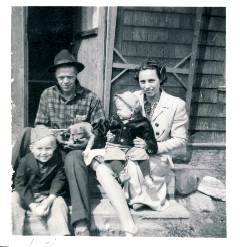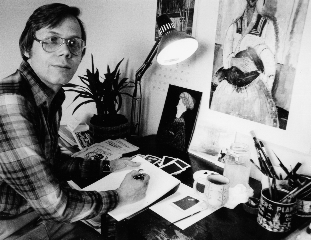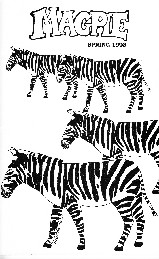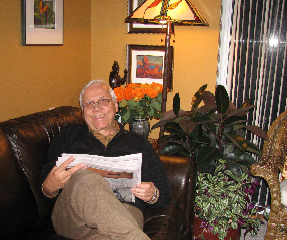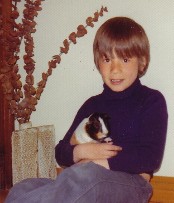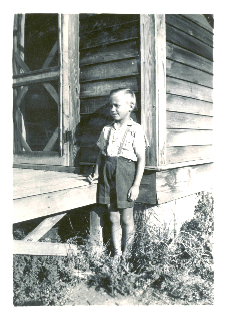
It seemed like, when I was a kid, the front step of wherever we were living was the spot for taking pictures.
Early Years
I was born February 1, 1943, into a world caught up in the throes of World War II. My parents lived on a small homestead in central Alberta, far away from the fields of conflict, but the uncle I was named for, Glen Daily, was with the Canadian forces in Italy, and my father’s youngest brother, Norman Huser, was killed on a Normandy beach on D Day. Another uncle, Einer Huser, was a paratrooper, but the war came to an end before he saw active service.
My father, Harry Huser, was not much of a farmer. He was happier with a sketching pencil in his hand or doing fine carpentry. When my older brother, Dale, and I were still very young, my mother, Beatrice Daily Huser, urged a move to the nearby tiny hamlet of Ashmont. She found work teaching in the area, while my dad worked at a number of jobs – logging, carpentry, garage mechanics, eventually driving a school bus. He had the small homestead house moved down to Ashmont and turned it into Harry’s Hobby Shop, and it was here that he was always the happiest – at his turning lathe, or creating intricate designs with a fretsaw.
My family grew with the arrival of two sisters, first Karen, and then Sharon.
Want to know a bit more about my life during these years? — check out Road Trip and Christmas Eve.
A Librarian with Green Paint on His Fingers
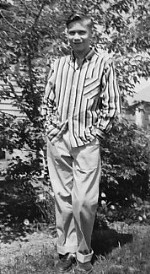
Ah, yes – a very cool teenager in 1958. I actually did own some blue suede shoes – but I’m just wearing penny loafers here. The world would be looking pretty fuzzy (without my glasses).
While Ashmont had a consolidated school, the town itself was very small. As a teenager, I was always looking for chances to get away to the “big city” – Edmonton – where I could catch the latest Elvis Presley movie, and browse through its gigantic library (even if I wasn’t allowed, as a non-resident, to check any of the books out). Libraries intrigued me, and when I found out there were a number of boxes of books stowed away in the attic of the Ashmont Municipal Building, I convinced the town officials to let me set them out again in what had once been a makeshift library with rough wooden shelving and a barrel-shaped, wood-burning stove. One general merchant even donated some paint for the shelves. Convincing a couple of friends to help me, we painted the shelves – two coats in fact, which never quite seemed to dry – and the book covers were always encrusted with bits of apple green paint. My friends and I “played librarian” – but mainly the old, donated book-of-the-month club selections and ancient encyclopedia sets provided me with reading material for my mid-teen years.
The Popsicle Kid Goes to the Big Apple
When I was fourteen, I won a week-long all-expenses-paid trip to New York for my mom and me. I’d come across the contest information on the back of a comic book. It involved cutting out the initial letter from the Popsicle logo off a package and turning it into a design of some sort. I remember creating four designs (certain that it would increase my chances fourfold) and mailing the designs away to a United States address.
At the time we didn’t even own a telephone and news of my win was brought over to us by the railway station agent bearing a telegram.
My mom was pegging laundry to our backyard clothesline when we got the telegram. Talk about a total look of amazement when she discovered its contents. Covert as I was as a teenager, I hadn’t even told her I’d entered the contest. She dropped her tubful of sheets and gave me a big hug.
It turned out that there was a small horde of winners — but what was most interesting was the discovery that actually many of the parents had created the winning designs, entering them in their children’s names. I remember my mother shaking her head over this bit of family fraud.
For a kid who had seen few buildings taller than the Ashmont grain elevator, a trip to the skyscrapered canyons of New York was an adventure indeed. It was a whirlwind tour — the Statue of Liberty, the Bronx Zoo, Radio City Music Hall, the Dodgers playing at Ebbet’s Field.
Movie-mad in Edmonton
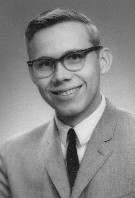
In 1963, The Edmontonian Magazine asked me to give them a photo of me to accompany some of my film reviews so I remember going to a studio and having a “professional photo” taken. That’s me at 20.
In 1958 Mom and Dad decided it was time to leave our country environs and move to Edmonton. I would be going into grade 12 and then on to university. There would be better job opportunities for my brother. In those first couple of years in the city, though, I think my main occupation was catching up with as many movies as I possibly could. We now had a TV set with its offerings of afternoon films and late-night movies – there were only a couple of channels but that was two more than we had in Ashmont! – and the theatres around town gave me the chance to catch not only the new releases but a host of older movies in double features at the second-run cinemas. Yes – I was definitely movie crazy. When I completed two years of university and began teaching junior high school, I took on a part-time job reviewing films for The Edmontonian, a weekly community and entertainment magazine. It was a small magazine and I think I was paid something like ten dollars a column (for which I did my own graphics), but I discovered I loved writing about films almost as much as going to them.
Paint brushes, Children’s Books, and a Magpie
After teaching junior high for three years, I wasn’t sure this was the life for me. Maybe I was meant to be an artist. I’d been able to take art courses as a major at university and the Vancouver School of Art accepted me into a second-year of their program in 1964. This was the first time I’d lived away from home and, much as I loved Vancouver, I decided to return to Edmonton the following year and resume my teaching. I spent another year teaching junior high, and then a couple of years teaching elementary grades. At that point, I thought I might quit and become a commercial artist, specializing in fashion illustration, but after a few months spent getting a portfolio together, I changed my mind and headed back for another year in the Education Faculty at the University of Alberta.
I began focusing on courses in school librarianship and children’s literature, and, when I returned to teaching, it was to take up a career as a teacher-librarian in elementary schools. I loved this job, and, increasingly, I was drawn to the world of children’s books, joining selection committees, and securing a position as a reviewer of children’s literature for The Edmonton Journal. In 1978, the Edmonton Public School Board had some money available for special projects so I proposed the development of a quarterly magazine featuring writing and graphics by students and took on the job of managing editor of the publication – a position I maintained until I left the school board in 1996. Unique in the annals of school district publications, the magazine, Magpie, continued to be published until 2008. For my last 8 years with the board, I was a learning resources consultant, working not only with Magpie, but selecting media and assisting in libraries throughout the district.
I didn’t think I had enough going on in the 1970s so I adopted a seven-year-old boy, Casey. Instant fatherhood! Want to know more about this experience – check out Father’s Day.
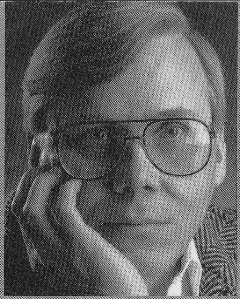
That’s me trying a “serious author” look for my back-cover photo. I told the photographer there would be a bonus for him if he could give me cheekbones, but he couldn’t manage it.
Grace Lake
In the 1970s, I continued to work on my own creative writing whenever I had time. During the 70s and 80s, The Edmonton Journal featured an annual writing competition and, in different years, I took first prize for short fiction, poetry and the one-act play. When I had the opportunity, I took courses from writers on the U of A campus – Margaret Atwood, Rudy Wiebe, and W. O. Mitchell.
With publication of short stories in Prism International and Dandelion, I was encouraged to study writing in more depth, and returned to the U of A to take a Masters in English in the mid 1980s. My creative thesis, The Flowers of Alberta, was picked up by NeWest Press and published as Grace Lake, part of their Nunatak series of first novels. Well-reviewed, it became a finalist for a W. H. Smith/Books in Canada First Novel Award.
Touch of the Clown
When I retired from Edmonton Public Schools in 1996, I found myself sorting through a file drawer of works in progress, and decided to continue working on a young adult novel about a clown actor who intervenes in the lives of a couple of neglected kids in a downtown Edmonton neighborhood. After workshopping a draft with my Edmonton writing group (several writers – we met intermittently to critique each other’s work), I sent the manuscript of Touch of the Clown to a number of Canadian publishers. Groundwood contacted me and indicated they would be interested in publishing the book, and put me in touch with Shelley Tanaka, one of their authors who also worked as an editor for the house. A lucky day for me – Shelley has been my editor on my young adult novels, all of which have won prizes or been shortlisted for awards.
Jeremy’s Christmas Wish
At this time, I was also working as a sessional instructor in Elementary Education at the U of A, was briefly co-owner of Leaves, a flower and secondhand book shop, and was editing a series of beginning chapter books for a small local press, Hodgepog. As the press moved to Vancouver and I concluded my editing work, Hodgepog published one of my own novels for younger readers – Jeremy’s Christmas Wish.
Stitches and Skinnybones and the Wrinkle Queen

Receiving my award from Governor General Adrienne Clarkson at Rideau Hall in 2003. The book we are holding is a copy of Stitches the Canada Council had specially bound in red leather with a puppet appliquéd to the cover. The book is something I continue to treasure – the $15,000 prize money is long gone!
In 2003, Groundwood published my second young adult novel, Stitches. A story of a bullied teen and his close friendship with a handicapped girl, Stitches won a Governor General’s Award for Children’s Literature. It also garnered Alberta’s R. Ross Annett Award as the best children’s book of the year. In 2007, my next young adult novel, Skinnybones and the Wrinkle Queen, became a Governor General’s silver medal winner, and was a finalist for the Sheila Egoff Award for Children’s Literature in B. C. and the Red Maple Award in Ontario.
Life in Vancouver
After traveling back and forth between Edmonton and Vancouver for a few years, in 2008 I made Vancouver my permanent home. I’d been doing sessional work for UBC’s Education faculty and, since 2006, teaching a Writing for Children and Young Adults component of UBC’s online MFA in Creative Writing program.
So…what is my life like in Vancouver these days? I am part of a co-op community. This involves some volunteer hours each month, so I work on the newsletter, and have been serving on the board of directors. My studio window looks out onto greenery the year round – something I love. When there is snow in Vancouver, it never lasts for long. Rain – yes, but I’m more of a rain person than a snow-and-ice person. My patio backs against an elementary school park and the sounds of children out playing at recess have a pleasant echo of those countless hours I spent working (and playing) with children this age. I live alone but I often have visitors – mainly family and friends from Alberta.
When I’m not at the computer teaching my online course or working on my own writing, you’ll likely find me curled up with a book, or watching one of the old movies I collect. At other times you might catch me with my paint tubes, papers and canvas spread over my kitchen work table – or, with ear-phones on, playing my electric keyboard-piano (ear-phones because I’m very out of practice and don’t want to inflict pain on my neighbors). Exercise isn’t really high on my list of things to do, but I do love walking around Vancouver’s city streets and parks.
Christmas Eve
So…Vancouver actually does get winter in a form other than liquid. As I write this, I am into my third year living here and yesterday was the first time I’ve seen more than a dusting of snow on my patio.
Mind you, I wasn’t particularly enthralled to be facing this fact, although I did have to admire the effect of the snow on the branches of the rhododendron outside my living-room window. That is, until one of the branches broke under the weight and collapsed into my plastic lawn chair like some visiting dowager expecting me to bring tea (or mulled wine) out to her.
Coming from the prairies, I am no stranger to cold and snow. I grew up rubbing ice-tingling fingers together over coal heaters and kitchen cookstoves. At my grandmother’s, the perfect place to sit and read a book on a cold winter day was on top of the woodbox right beside the kitchen stove. I think I may still have grooves on my backside from the pieces of cut wood my brother and I carried in by the armload and dumped into the bin until it was full.
The sound that woke me on winter mornings was the sound of my mother or my grandmother rattling the grates of these stoves as they revived the fires from coal embers and stoked them. I used to wonder if the name of the small town where I lived, Ashmont, had come from all of the piles of ashes that grew throughout the winter as people dumped out their ashpans at the edges of gardens, or behind bushes and outbuildings.
Christmas Eve, in the midst of all of this cold and snow, has a particular texture for me as I remember those years in Ashmont. Of course, when you’re a kid, it’s almost impossible to fall asleep on the night before Christmas — even when you’re a teen. My brother, with whom I shared a bed in an upstairs bedroom, always seemed to drift off before I did.
Restlessly, I’d sit up and, with a quilt wrapped around me, part the curtains by the bed, and look out over that night landscape of my tiny town. Our bedroom window faced out onto the backs of the buildings that lined Main Street. As the evening edged towards midnight, I could see the odd light still on in the kitchens and living rooms that nudged the post office and the general stores, while soft snow hovered like swarms of tiny white moths around the streetlamp at the corner of the alley.
My father, when he built our two upstairs bedrooms — one for my sisters, the other for my brother and me — had cut a rectangular hole in the floor on each side of the partition and into this he’d fitted a wooden grate. The grate allowed heat in from the living room heater below. But it also allowed music from the radio to drift up and the songs of Christmas, tuned low, filled our rooms like night itself.
If I stayed awake long enough, I was certain I’d catch my parents in the act of filling our stockings that hung limply, attached with makeshift loops, to a chairback across the room. There was just enough light from the streetlamp, with the curtains open, to see them. Of course, I’d pretend I was asleep.
But I never caught them. Maddeningly, they sat in the kitchen below, playing an endless game of cribbage, knowing somehow that the litany of fifteen-twos and fifteen-fours would outlast any effort of mine to apprehend that adult world of Christmas stocking-stuffing.
I don’t know if we’ll still have snow at Christmas this year, but for all of you, I wish the pleasure — the treasure? —– of your own memories of the night before…
Road Trip

The Huser family posed in front of my dad’s schoolbus. That’s me, squinting, with a hand over my eyes.
A film I saw recently and thoroughly enjoyed was Little Miss Sunshine. This saga of a road trip in a Volkswagon van as dysfunctional as the family inside it left me laughing, and I couldn’t help thinking about a time when I was the age of Abigail Breslin, the youngster intent on winning a beauty pageant for kids, when our only mode of transportation was a pumpkin-colored school bus my dad owned.
The bus was responsible for one half of our family income — my mom taught school; Dad drove the school bus. But it often seemed the bus itself consumed any profit. It had put in its years on rough barely-graveled roads, and its shaken innards often seized up.
With the cost of repairs and tires, we certainly couldn’t afford another vehicle, so the orange bus got us into St. Paul for grocery shopping, to the hospital in Elk Point to get our tonsils removed, and — when summer came — on the road for our holidays.
Like the Hoovers in Little Miss Sunshine, the Husers on the highway presented a somewhat unique tableau. While the school bus was not very comfortable, it was possible to get lots of people into it. On one trip to the mountains, my mother’s parents, an aunt and assorted cousins joined my mom and dad, two sisters, my brother and me.
My aunt, who was more of an older sister to us, organized back-of-the-bus activities that included tickle sessions, storytelling, singing forbidden songs such as “Wasn’t God Who Made Honkytonk Angels,” and re-enacting sequences from her favorite movies (the fall of Atlanta from Gone With the Wind was a particular favorite). When the shrieking or laughing or crying became too loud, admonitions to “settle down” would volley back from the front of the bus, where the adults sat.
With such a range of kidney capabilities, there were many stops. Grandpa Daily, who liked to chew tobacco, took advantage of any roadside respite to work up a plug, reluctantly spewing it out onto ditch dandelions before reboarding. Grandma, commandeering a sharp-edged pancake turner, dug up plants for her flower garden. My mother strode up and down, reciting poetry about mountains, how “the splendor falls on castle walls.” My dad smoked as he went around and kicked tires. We kids raced through the road embankment collecting rocks.
Stopping for the evening involved hauling out and erecting a canvas tent. There wasn’t room for everyone in it, so we kids took turns sleeping in the school bus. Those bus seats, covered with a hardy vinyl, might as well have been carved from stone.
My brother felt himself a winner, though, the evening he and my aunt had settled in for the night when a sudden hailstorm struck the farmer’s field where we’d pitched our tent. While the rest of us, inside our canvas shelter, held onto whatever we could grasp of the tent’s edges to keep it from flying away, they watched from the haven of the bus.
Hail manages to break the seal on tent canvas, and, once the hailstorm rolled away, we emerged, wet and bedraggled. But my grandmother had somehow managed to save two apple pies from becoming drenched. I can’t remember why they were in the tent. An evening snack for the adults?
We were all awake, and the school bus was filled with chatter and laughing, as we ate Gram’s pie and watched our assortment of marble-sized hailstones melt in the spot where we’d herded them into the aisle. That night everyone slept in the orange bus. Well…perhaps “slept” is too optimistic a word. I won’t speak for the adults, but children, with the taste of apple pie in their mouths, and the wild wonder of a storm already congealing into the words of a story to be told again and again, had no trouble at all.
Father’s Day
Father’s Day. I suspect my reason for becoming a father wasn’t particularly to end up on the receiving end of the latest Hallmark card figuring out some new way to rhyme ‘glad’ with ‘Dad.’ But I have to admit to having all of these cards tucked away; there’s some things you just don’t throw out.
Fatherhood arrived very suddenly for me, when I was 33. True, there was a wait of several months (less than nine though) as Social Services conducted a background study into my home and habits. Once I was approved — and after a preliminary meeting — the child arrived, a full-blown seven-year-old.
Life was never to be the same. I was plunged into a world of frequent laundry, regular meals, knock-knock jokes, guinea pig pets, fishing excursions, helping with homework, finding babysitters, sorting out hockey gear, refereeing playground squabbles.
When the seven-year-old arrived, I lived in one of the older walk-up apartments in Edmonton’s university area. I’d moved into it on the strength of its proximity to classes I was taking to upgrade my teaching credentials — definitely not on the strength of its laundry amenities. The walk-up’s washing room was actually a walk-down to the basement where an antique electric washing machine and wringer waited for those brave enough to use it. No drier — but some kind of a complicated scaffolding of wooden doweling for hanging clothes on.
The seven-year-old was intrigued by this netherworld, managing to instantly collapse the clothes rack and reassemble it in a different configuration. He was also determined to help this new dad with the process of feeding socks through the wringer. Imagine the chagrin of the caring father when he noticed his child’s hand and arm following a sock into the wringer.
Anyone knowledgeable about machines would have had the wherewithal to spring the tension release on the wringer. My knowledge is piecemeal at best. Didn’t know there was a tension release bar, but I did know how to reverse the wringer’s action. So that’s what I did, and the arm and hand re-emerged (child still attached). Thank heavens there was barely any tension left in the tired old wringer anyway.
I remembered wondering if newly adopted children were removed from homes where they’d been wrung out. But the child (with an arm that was sore for a couple of days) stayed.
And I got my first Father’s Day card.

